tow CADILLAC SEVILLE 1996 4.G Owners Manual
[x] Cancel search | Manufacturer: CADILLAC, Model Year: 1996, Model line: SEVILLE, Model: CADILLAC SEVILLE 1996 4.GPages: 354, PDF Size: 20.21 MB
Page 39 of 354
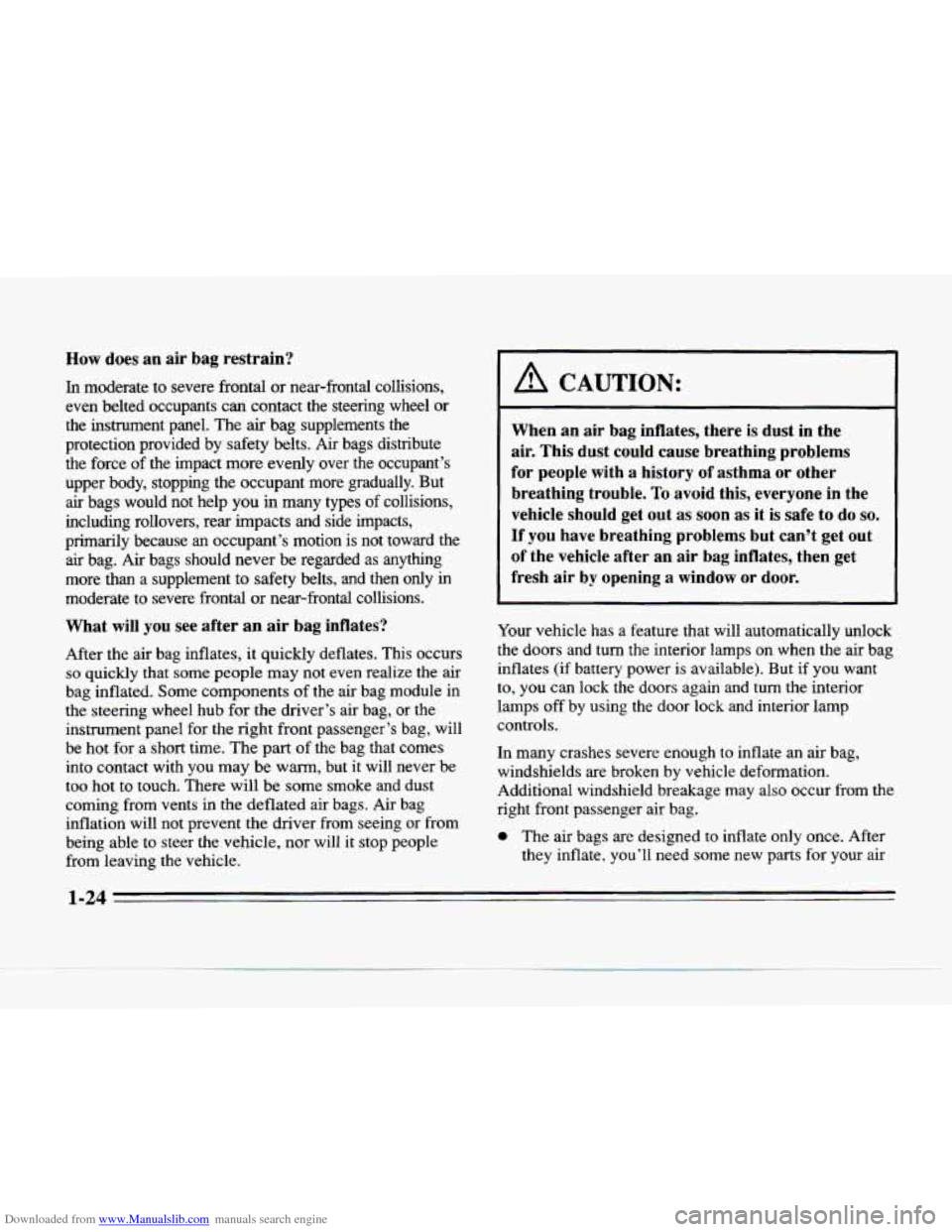
Downloaded from www.Manualslib.com manuals search engine How does an air bag restrain?
In moderate to severe frontal or near-frontal collisions,
even belted occupants can contact the steering wheel or
the instrument panel. The air bag supplements the
protection provided by safety belts.
Air bags distribute
the force of the impact more evenly over the occupant’s
upper body, stopping the occupant more gradually.
But
air bags would not help you in many types of collisions,
including rollovers, rear impacts and side impacts,
primarily because
an occupant’s motion is not toward the
air bag. Air bags should never be regarded as anything
more than
a supplement to safety belts, and then only in
moderate to severe frontal or near-frontal collisions.
What will you see after an air bag inflates?
After the air bag inflates, it quickly deflates. This occurs
so quickly that some people may not even realize the air
bag inflated. Some components
of the air bag module in
the steering wheel hub for
the driver’s air bag, or the
instrument panel for the right front passenger’s bag, will
be hot for a short time. The part
of the bag that comes
into contact with you
may be warm, but it will never be
too hot to touch. There will be some smoke and dust
coming from vents in the deflated air bags. Air bag
inflation will not prevent the driver from seeing or from
being able to steer the vehicle, nor will it stop people
from leaving the vehicle.
~
A CAUTION:
When an air bag inflates, there is dust in the
air. This dust could cause breathing problems
for people with a history of asthma
or other
breathing trouble.
To avoid this, everyone in the
vehicle should get out as soon as it is safe to do
so.
If you have breathing problems but can’t get out
of the vehicle after an air bag inflates, then get
fresh air by opening
a window or door.
Your vehicle has a feature that will automatically unlock
the doors
and turn the interior lamps on when the air bag
inflates
(if battery power is available). But if you want
to, you can lock the doors again and turn the interior
lamps
off by using the door lock and interior lamp
controls.
In many crashes severe enough
to inflate an air bag,
windshields are broken by vehicle deformation.
Additional windshield breakage may also occur
from the
right front passenger air bag.
0 The air bags are designed to inflate only once. After
they inflate, you’ll need
some new parts for your air
-24
Page 57 of 354
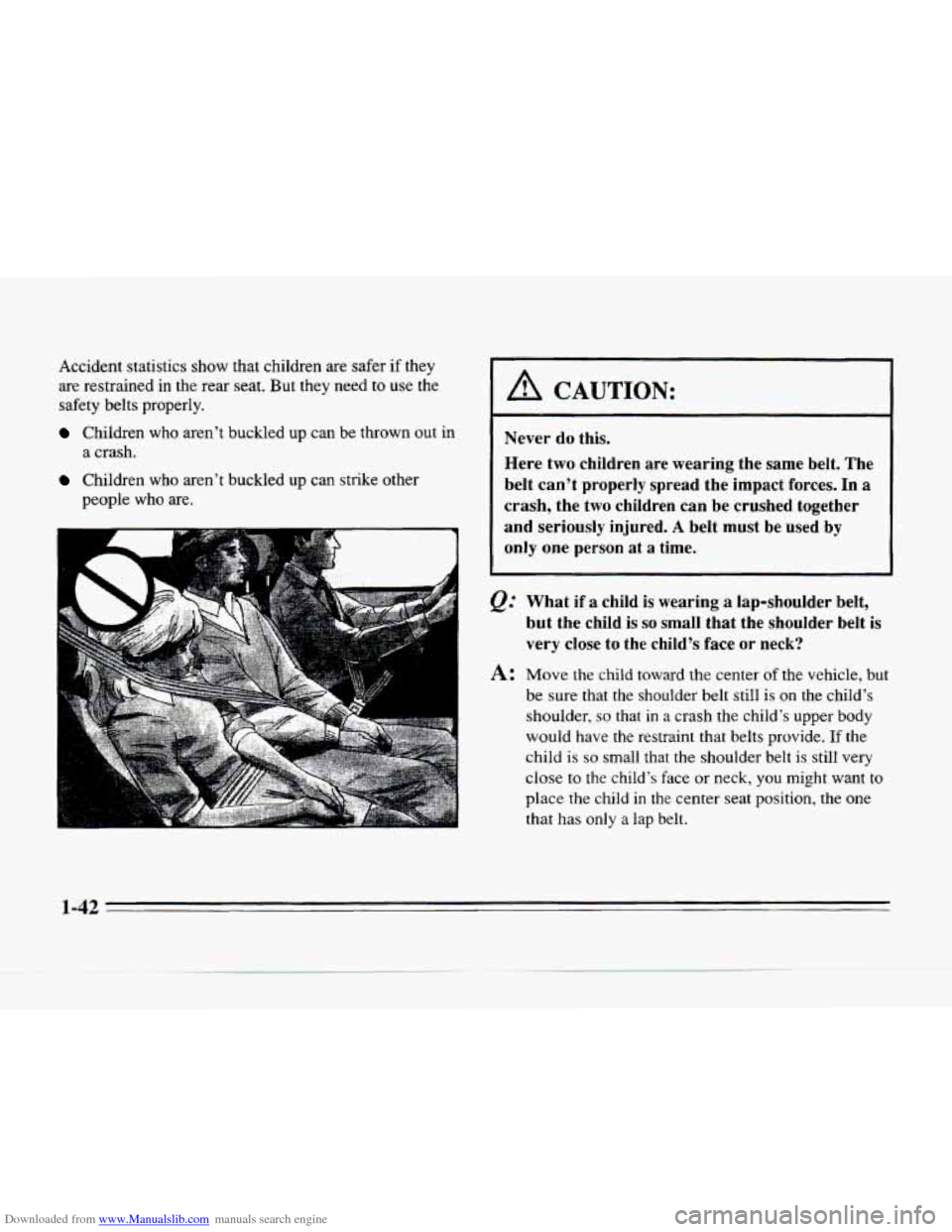
Downloaded from www.Manualslib.com manuals search engine Accident statistics show that children are safer if they
are restrained
in the rear seat. But they need to use the
safety belts properly.
Children who aren’t buckled up can be thrown out in
a crash.
Children who aren’t buckled up can strike other
people who are.
A
4
A CAUTION:
Never do this.
Here two children are wearing the same belt. The
belt can’t properly spread the impact forces. In
a
crash, the two children can be crushed together
and seriously injured.
A belt must be used by
only one person at
a time.
Q.’
A:
What if a child is wearing a lap-shoulder belt,
but the child
is so small that the shoulder belt is
very close to the child’s face or neck?
Move the child toward the center
of the vehicle, but
be sure that the shoulder belt still is
on the child’s
shoulder,
so that in a crash the child’s upper body
would have the restraint that belts provide.
If the
child is
so small that the shoulder belt is still very
close to the child’s face or neck, you might want to
place the child in the center seat position, the one
that has only
a lap belt.
1-42
Page 74 of 354
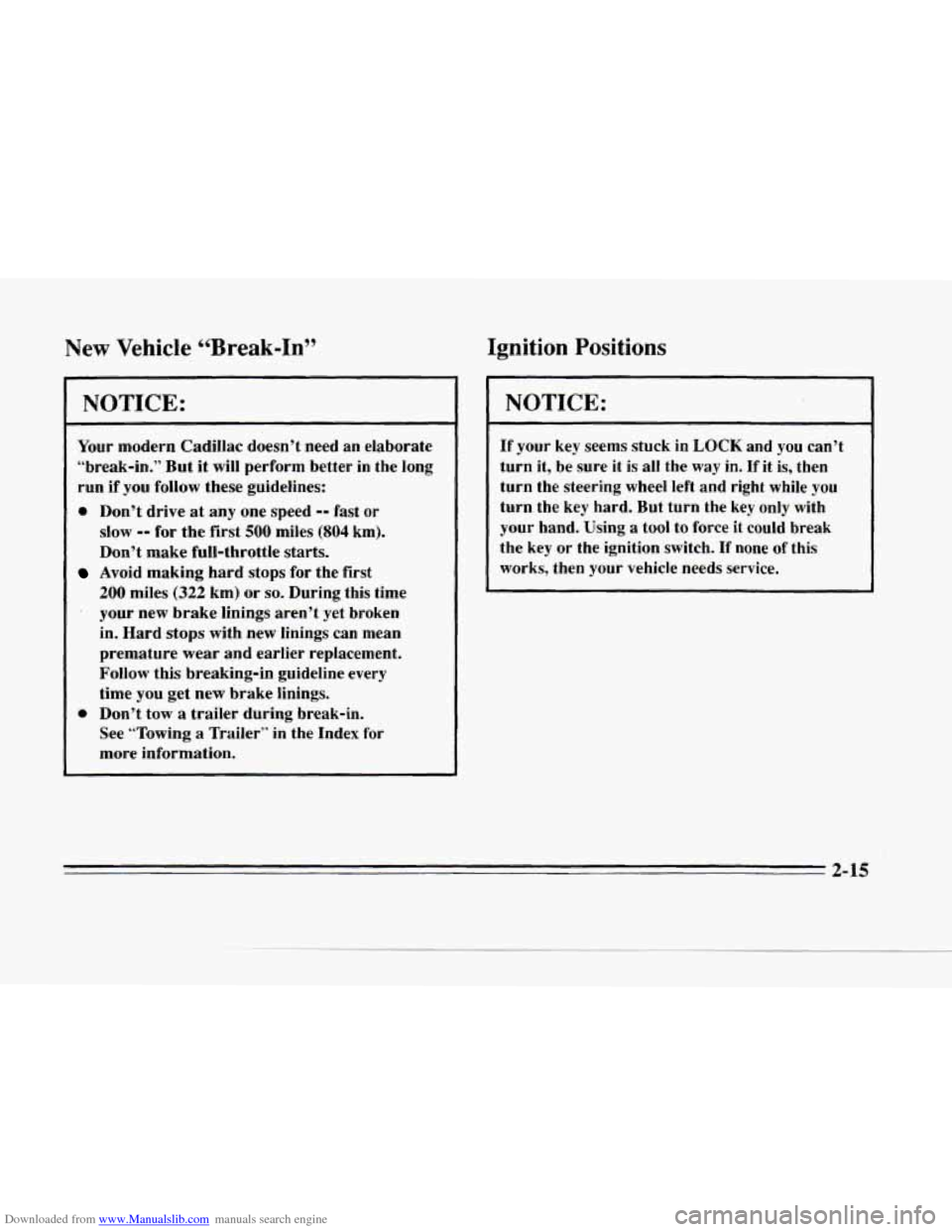
Downloaded from www.Manualslib.com manuals search engine c
c
New Vehicle 44Break-In’’
NOTICE:
Your modern Cadillac doesn’t need an elaborate
“break-in.” But it will perform better in the long
run if you follow these guidelines:
0 Don’t drive at any one speed -- fast or
slow -- for the first 500 miles (804 km).
Don’t make full-throttle starts.
Avoid making hard stops for the first
200 miles (322 km) or so. During this time
’ your new brake linings aren’t yet broken
in. Hard stops with new linings can mean
premature wear and earlier replacement.
Follow this breaking-in guideline every
time you get new brake linings.
See “Towing
a Trailer” in the Index for
more information.
0 Don’t tow a trailer during break-in.
Ignition Positions
NOTICE:
If your key seems stuck in LOCK and you can’t
turn it, be sure it is
all the way in. If it is, then
turn the steering wheel left and right while you
turn the key hard. But turn the key only with
your hand. Using a tool to force
it could break
the key
or the ignition switch. If none of this
works, then your vehicle needs service.
2-15
Page 75 of 354
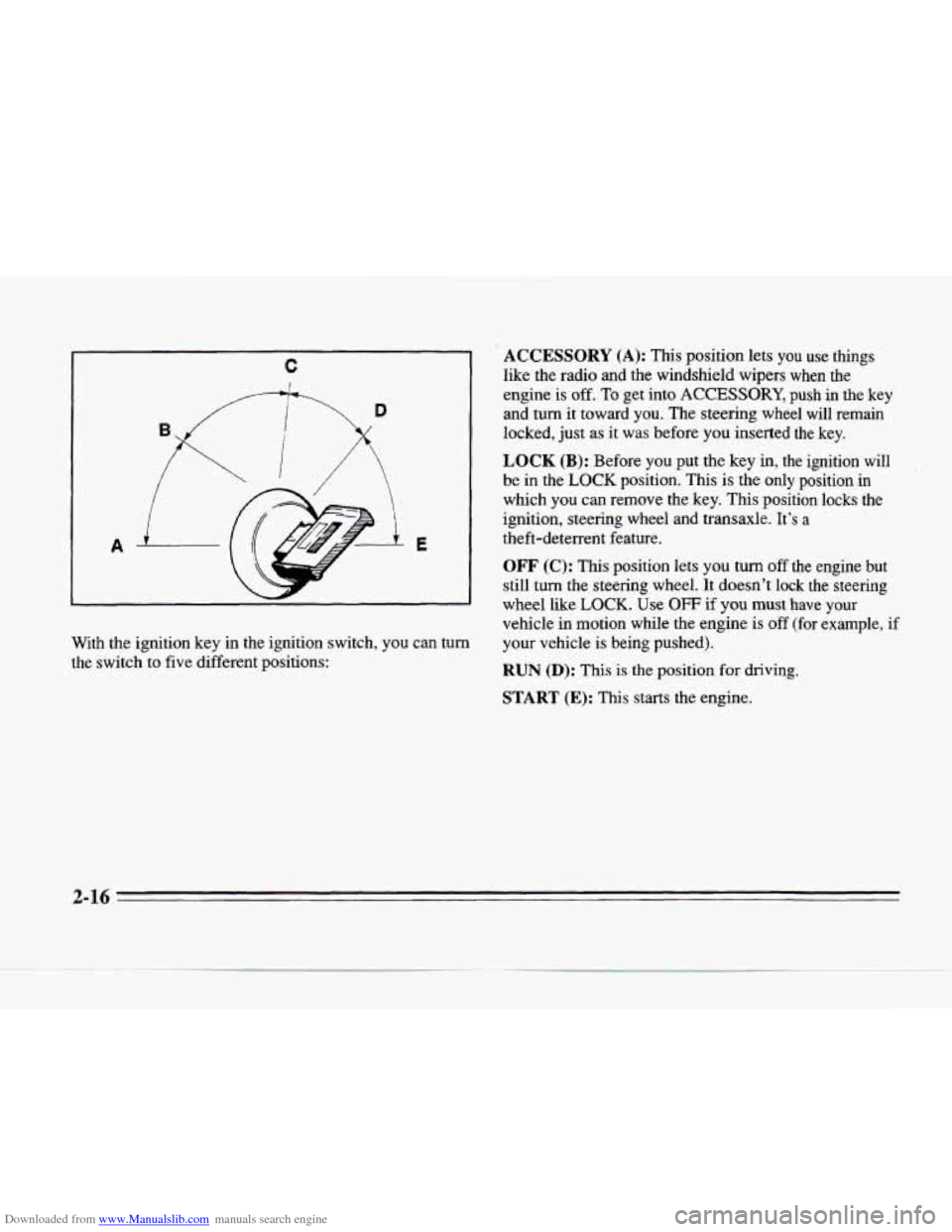
Downloaded from www.Manualslib.com manuals search engine C
I
W
With the ignition key in the ignition switch, you can turn
the switch to five different positions:
ACCESSORY (A): This position lets you use things
like the radio and the windshield wipers when the
engine is
off. To get into ACCESSORY, push in the key
and turn it toward you. The steering wheel will remain
locked, just as it was before you inserted the key.
LOCK (B): Before you put the key in, the ignition will
be in the LOCK position. This is the only position in
which you can remove the key. This position locks the
ignition, steering wheel and transaxle. It’s a
theft-deterrent feature.
OFF (C): This position lets you turn off the engine but
still turn the steering wheel.
It doesn’t lock the steering
wheel like
LOCK. Use OFF if you must have your
vehicle in motion while the engine is off (for example, if
your vehicle is being pushed).
RUN (D): This is the position for driving.
START (E): This starts the engine.
2-16
4
Page 77 of 354
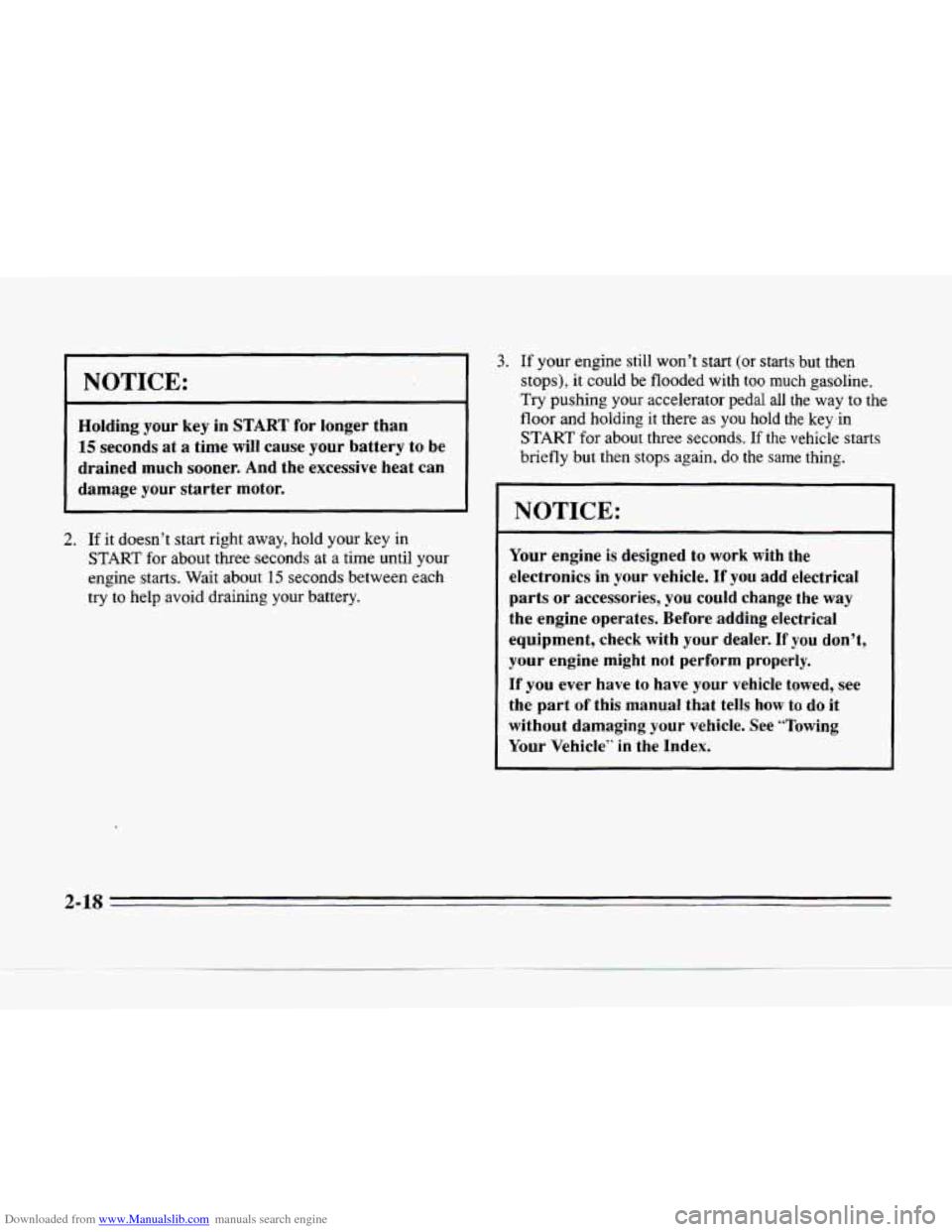
Downloaded from www.Manualslib.com manuals search engine w
NOTICE:
Holding your key in START for longer than
15 seconds at a time will cause your battery to be
drained much sooner. And the excessive heat can
damage your starter motor.
2. If it doesn't start right away, hold your key in
START for about three seconds at a time until your
engine starts. Wait about
15 seconds between each
try to help avoid draining your battery.
3. If your engine still won't start (or starts but then
stops), it could be flooded with
too much gasoline.
Try pushing your accelerator pedal all the way to the
floor and holding
it there as you hold the key.in
START for about three seconds. If the vehicle starts
briefly but then stops again, do the same thing.
NOTICE:
Your engine is designed to work with the
electronics in your vehicle. If you add electrical
parts or accessories, you could change the way
the engine operates. Before adding electrical
equipment, check with
your dealer. If you don't,
your engine might not perform properly.
If you ever have to have your vehicle towed, see
the part
of this manual that tells how to do it
without damaging your vehicle. See "Towing
Your Vehicle'' in the Index.
2-18
Page 80 of 354
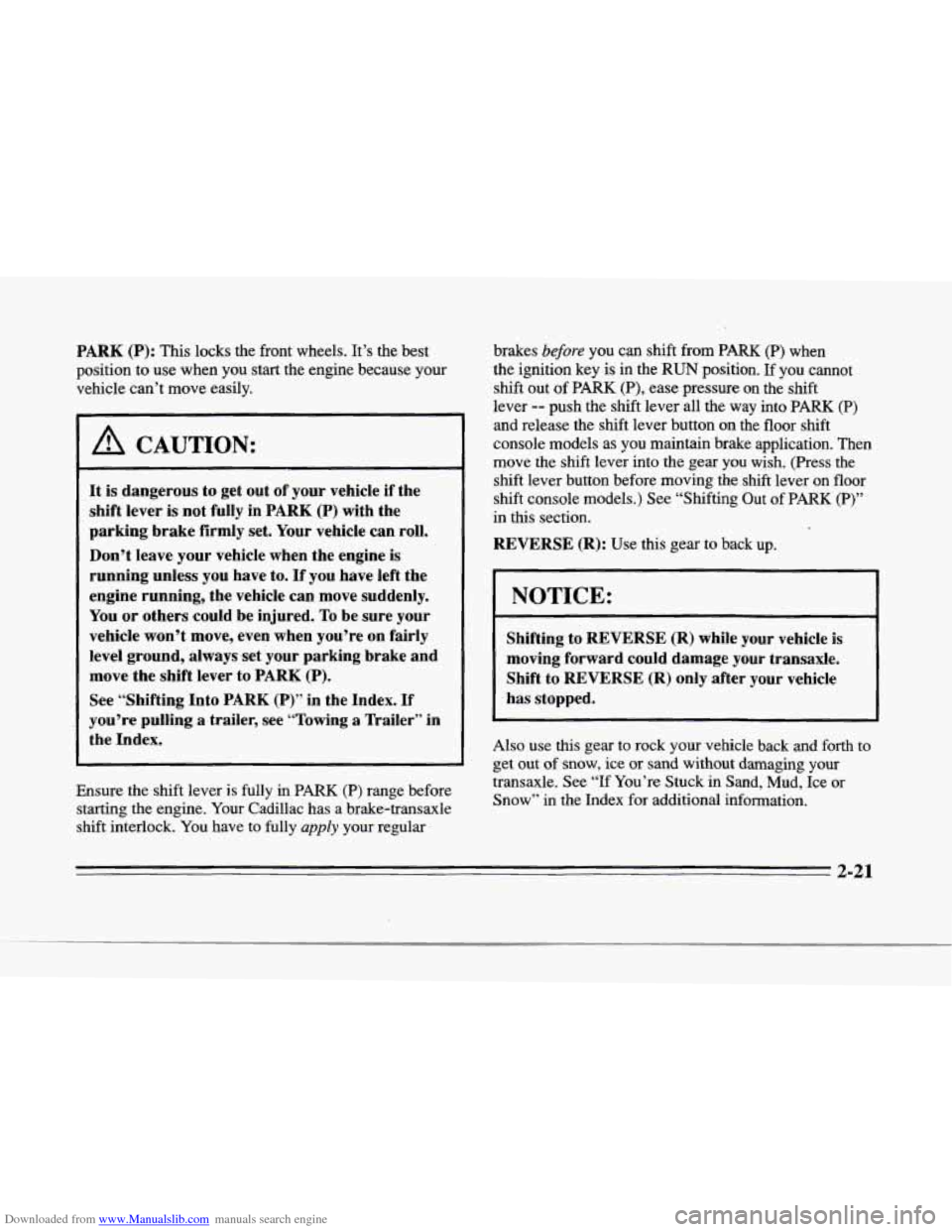
Downloaded from www.Manualslib.com manuals search engine r
I’
i
r“.
f
r.
r
PARK (P): This locks the front wheels. It’s the best
position to use when you start the engine because your
vehicle can’t move easily.
I A CAUTION:
It is dangerous to get out of your vehicle if the
shift lever
is not fully in PARK (P) with the
parking brake firmly set. Your vehicle can roll.
Don’t leave your vehicle when the engine is
running unless you have to.
If you have left the
engine running, the vehicle can move suddenly.
You or others could be injured.
To be sure your
vehicle won’t move, even when you’re on
fairly
level ground, always set your parking brake and
move the shift lever to
PARK (P).
See “Shifting Into PARK (P)” in the Index. If
you’re pulling a trailer, see “Towing a Trailer” in
the Index.
Ensure the shift lever is fully
in PARK (P) range before
starting the engine. Your Cadillac has a brake-transaxle
shift interlock. You have to fully
apply your regular brakes
before you can
shift from PARK (P) when
the ignition key is in the
RUN position. If you cannot
shift out
of PARK (P), ease pressure on the shift
lever -- push the shift lever all the way into PARK (P)
and release the shift lever button
on the floor shift
console models as
you maintain brake application. Then
move the shift lever into the gear you wish. (Press the
shift lever button before moving the shift lever on floor
shift console models.) See “Shifting Out of PARK (P)”
in this section.
REVERSE (R): Use this gear to back up.
NOTICE:
Shifting to REVERSE (R) while your vehicle is
moving forward could damage your transaxle.
Shift to
REVERSE (R) only after your vehicle
has stopped.
Also use
this gear to rock your vehicle back and forth to
get out of snow, ice or sand without damaging your
transaxle. See
“If You’re Stuck in Sand, Mud, Ice or
Snow” in the Index for additional information.
2-21
Page 81 of 354
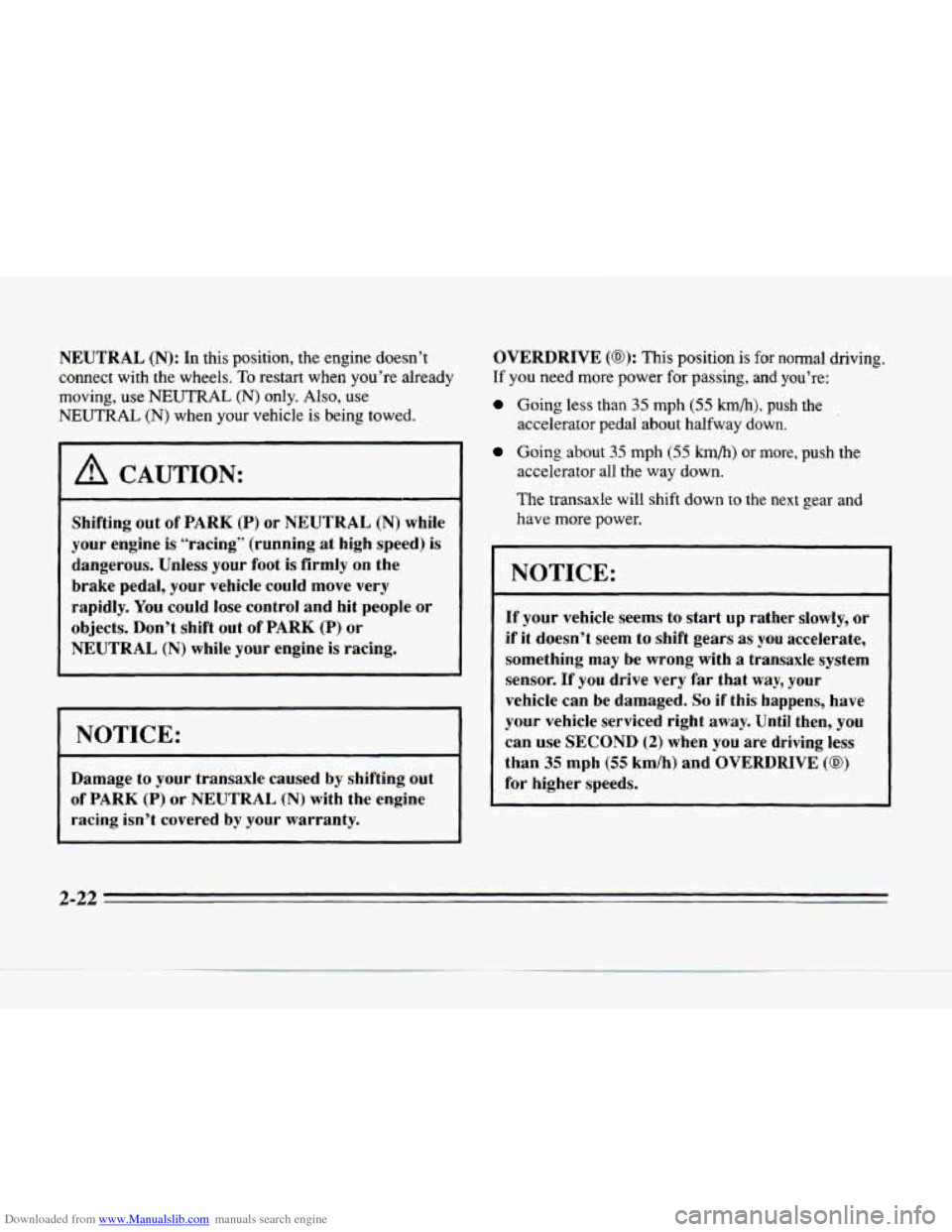
Downloaded from www.Manualslib.com manuals search engine NEUTRAL (N): In this position, the engine doesn’t
connect with the wheels.
To restart when you’re already
moving, use
NEUTRAL (N) only. Also, use
NEUTRAL (N) when your vehicle is being towed.
~~ ~
A CAUTION:
Shifting out of PARK (P) or NEUTRAL (N) while
your engine is “racing” (running at high speed) is
dangerous. Unless your foot is firmly on
the
brake pedal, your vehicle could move very
rapidly.
You could lose control and hit people or
objects. Don’t shift out of PARK
(P) or
NEUTRAL
(N) while your engine is racing.
I NOTICE:
Damage to your transaxle caused by shifting out
of
PARK (P) or NEUTRAL (N) with the engine
racing isn’t covered by your warranty. OVERDRIVE
(@): This position
is for normal driving.
If you need more power for passing, and you’re:
Going less than 35 mph (55 km/h), push the
accelerator pedal about halfway down.
Going about 35 mph (55 km/h) or more, push the
accelerator all the way down.
The transaxle
will shift down to the next gear and
have more power.
NOTICE:
If your vehicle seems to start up rather slowly, or
if it doesn’t seem to shift gears as you accelerate,
something may be wrong with a transaxle system
sensor. If
you drive very far that way, your
vehicle can be damaged.
So if this happens, have
your vehicle serviced right away. Until then, you
can use SECOND
(2) when you are driving less
than
35 mph (55 km/h) and OVERDRIVE (0)
for higher speeds.
c-
2-22
Page 82 of 354
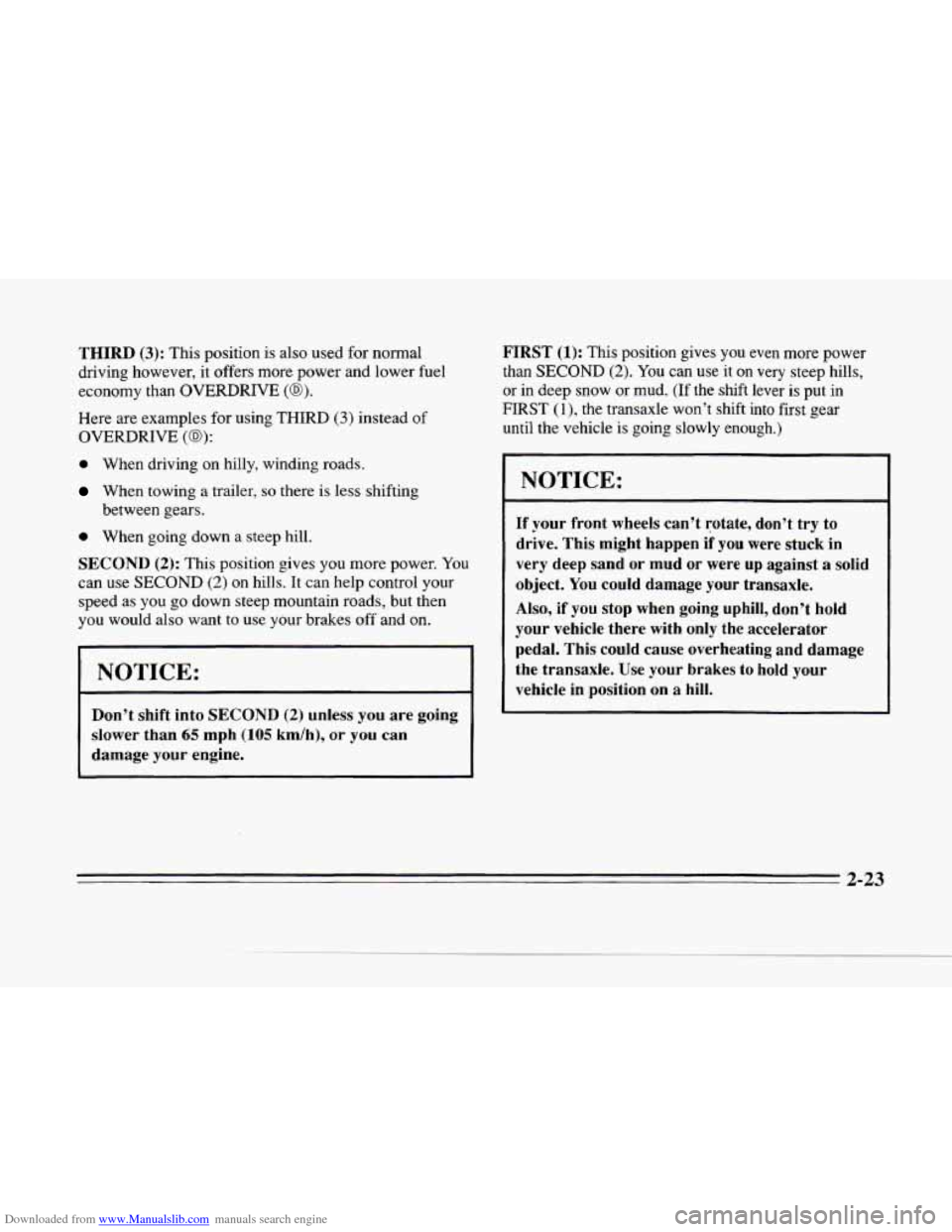
Downloaded from www.Manualslib.com manuals search engine r..
L
THIRD (3): This position is also used for normal
driving however, it offers more power and lower fuel
economy than OVERDRIVE
(@).
Here are examples for using THIRD (3) instead of
OVERDRIVE (a):
0 When driving on hilly, winding roads.
When towing a trailer, so there is less shifting
between gears.
0 When going down a steep hill.
SECOND (2): This position gives you more power. You
can use SECOND
(2) on hills. It can help control your
speed as
you go down steep mountain roads, but then
you would also want to use your brakes
off and on.
I NOTICE:
r
~~
Don’t shift into SECOND (2) unless you are going
slower than
65 mph (105 km/h), or you can
damage your engine. FIRST
(1): This
position gives you even more power
than SECOND
(2). You can use it on very steep hills,
or in deep snow or mud. (If the shift lever is put in
FIRST (l), the transaxle won’t shift into first gear
until the vehicle is going slowly enough.)
NOTICE:
If your front wheels can’t rotate, don’t try to
drive. This might happen if you were stuck in
very deep sand or mud or were
up against a solid
object.
You could damage your transaxle.
Also, if you stop when going uphill, don’t hold
your vehicle there with only the accelerator
pedal. This could cause overheating and damage
the transaxle.
Use your brakes to hold your
vehicle in position on
a hill.
2-23
Page 84 of 354
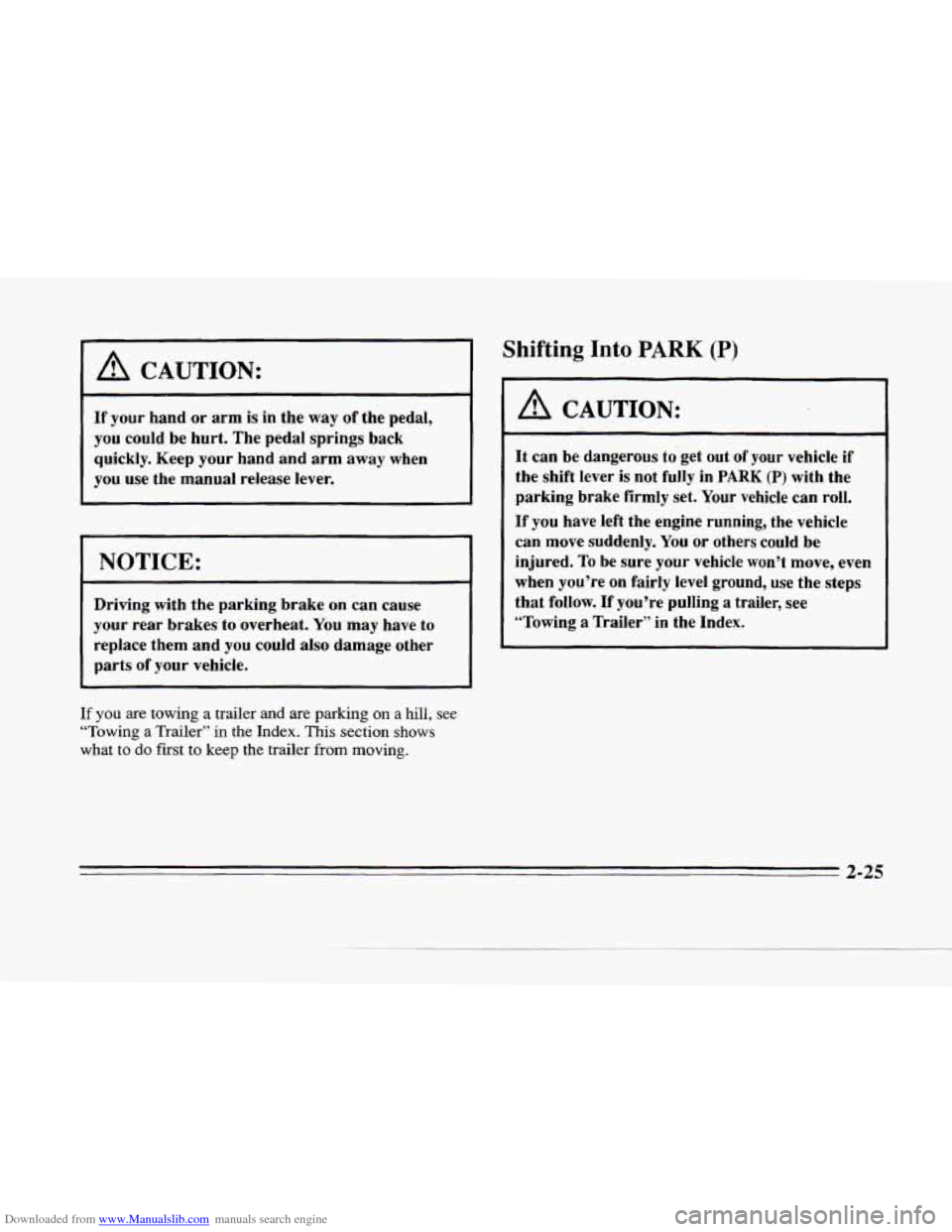
Downloaded from www.Manualslib.com manuals search engine i
I A CAUTION:
If your hand or arm is in the way of the pedal,
you could be hurt. The pedal springs back
quickly. Keep your hand and arm away when
you use the manual release lever.
I
NOTICE:
Driving with the parking brake on can cause
your rear brakes to overheat.
You may have to
replace them and you could also damage other
parts of your vehicle.
Shifting Into PARK (P)
1 A CAUTION:
If you are towing a trailer and are parking on a hill, see
“Towing a Trailer” in the Index. This section shows
what to do first to keep the trailer from moving. It
can be dangerous to’get out
of your vehicle if
the shift lever is not fully in
PARK (P) with the
parking brake firmly set. Your vehicle can roll.
If you have left the engine running, the vehicle
can move suddenly.
You or others could be
injured. To be sure your vehicle won’t move, even
when you’re on fairly level ground, use the steps
that follow.
If you’re pulling a trailer, see
“Towing
a Trailer” in the Index.
2-25
Page 85 of 354
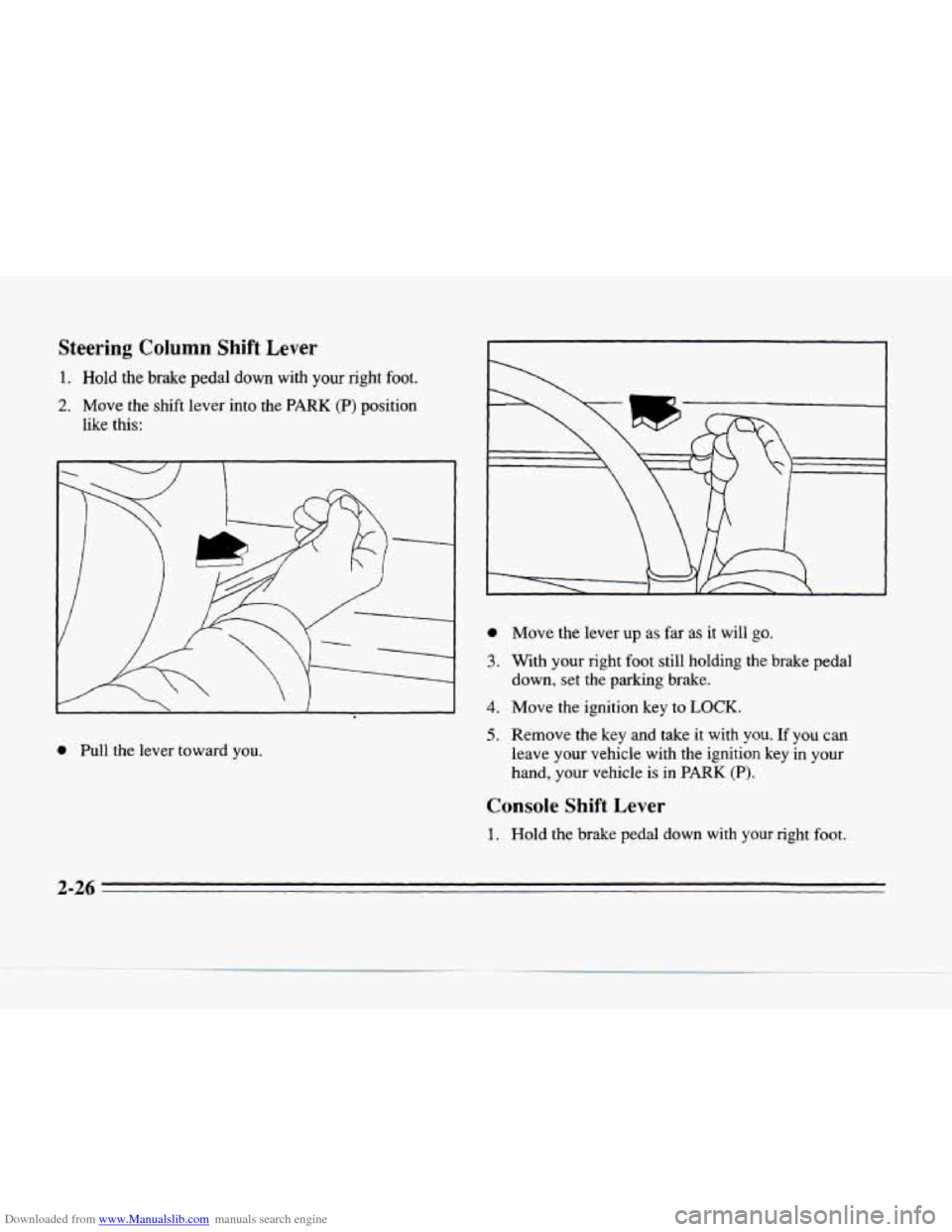
Downloaded from www.Manualslib.com manuals search engine Steering Column Shift Lever
1. Hold the brake pedal down with your right foot.
2. Move the shift lever into the PARK (P) position
like this:
0 Pull the lever toward you.
0
3.
4.
5.
Move the lever up as far as it will go.
With your right foot still holding the brake pedal
down,
set the parking brake.
Move
the ignition key to LOCK.
Remove the key and take it with you. If you can
leave your vehicle with the
ignition key in your
hand, your vehicle
is in PARK (P).
Console Shift Lever
1. Hold the brake pedal down with your right foot.
2-26